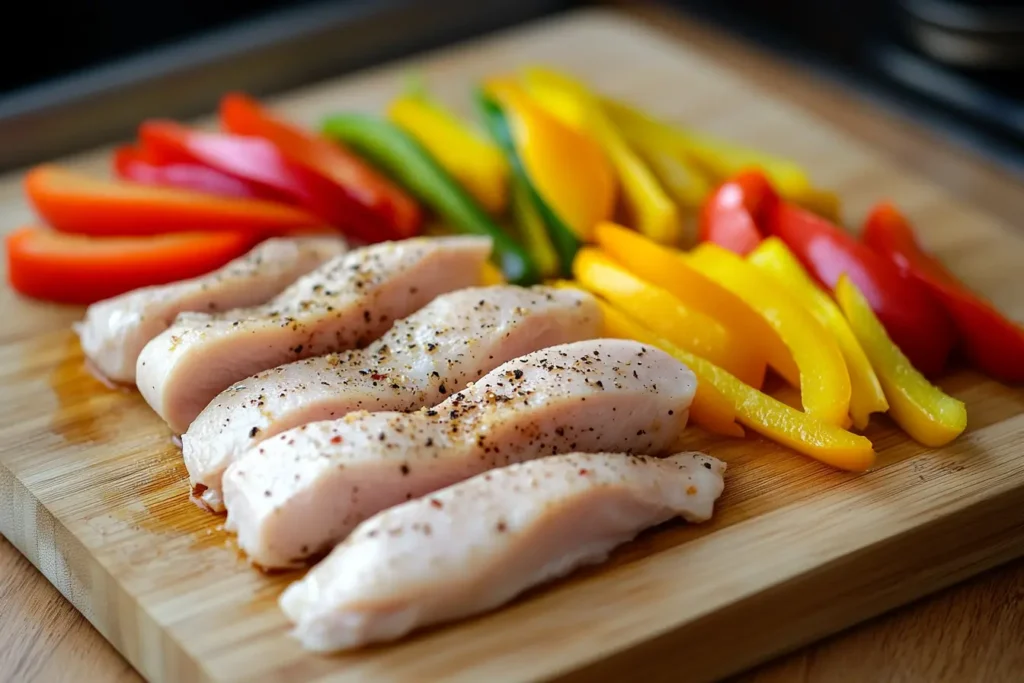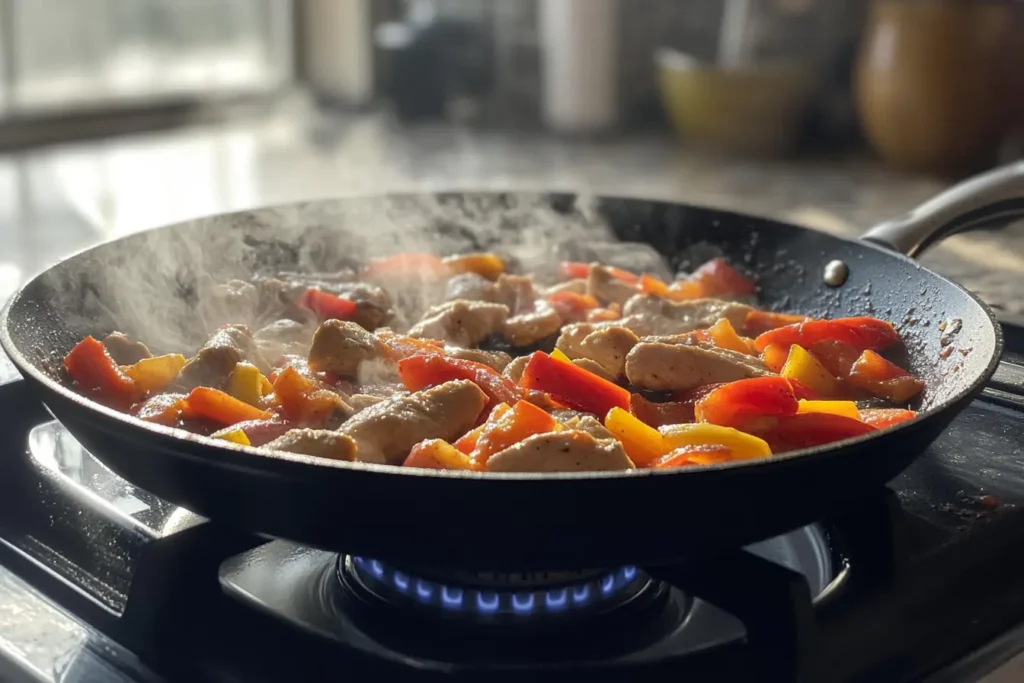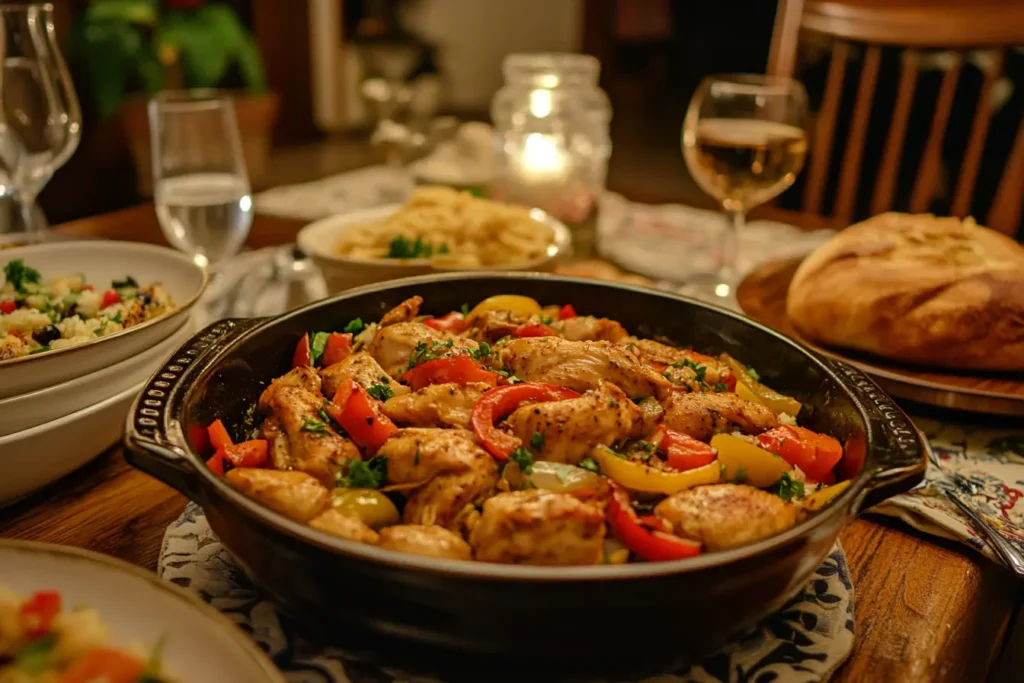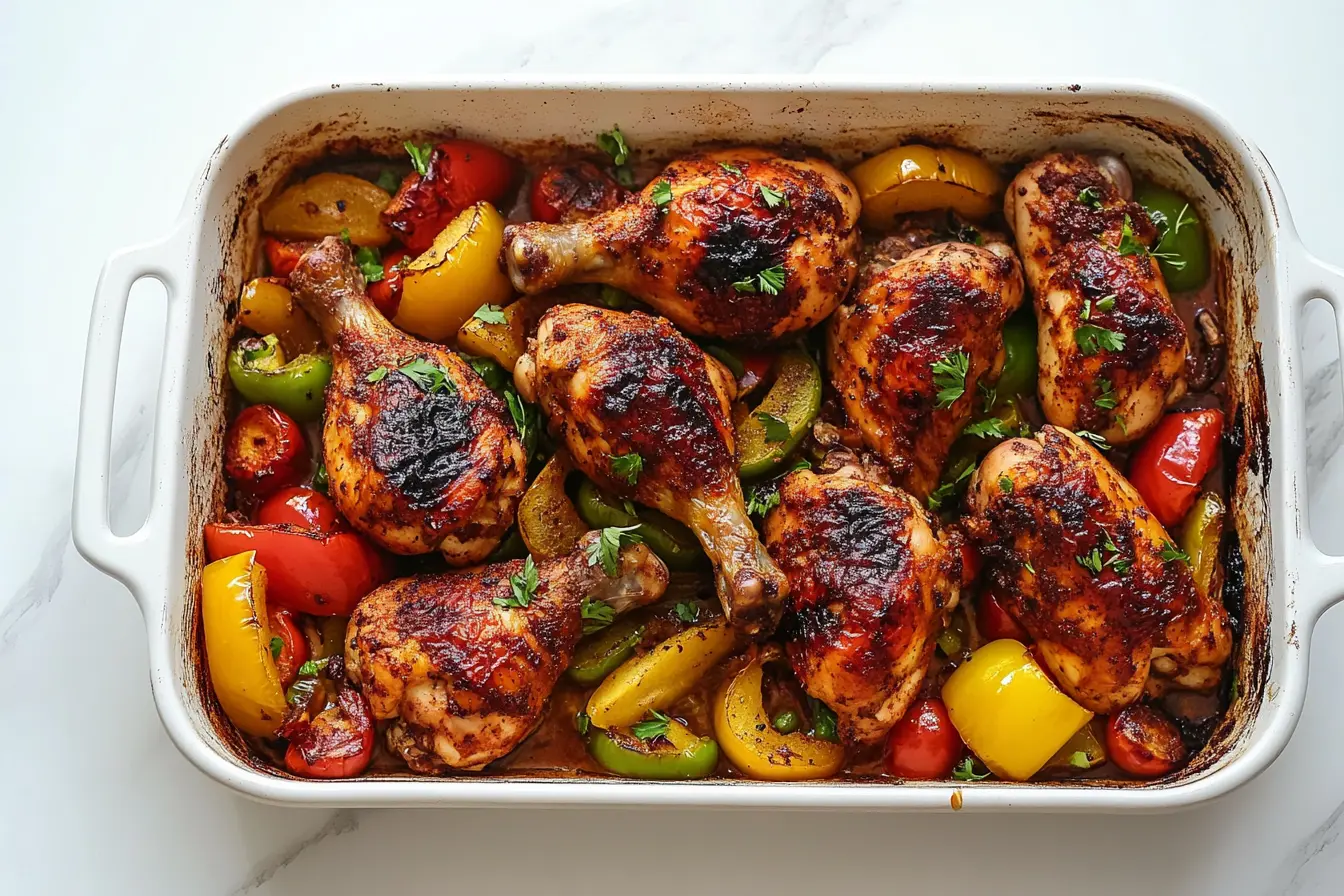Introduction
Discover a chicken and peppers recipe that’s quick, easy, and bursting with flavor. Perfect for weeknight dinners and family feasts.
In the upcoming section, we will delve into the art of making a chicken and peppers recipe that pleases everyone at the table. Although this dish often takes center stage at many family meals, it remains surprisingly simple to create. Because of its versatility, it adapts to countless flavor profiles. Check USDA guidelines for chicken safety to ensure best practices while cooking your protein. Additionally, consider learning about pepper varieties from agricultural extension resources for a deeper understanding of your ingredients. Furthermore, explore healthy cooking tips by visiting Harvard T.H. Chan School of Public Health’s nutrition source to find balanced approaches to your meal planning.
In the subsequent chapter, we will discover every element of this dish, from selecting the perfect chicken cuts to seasoning and cooking methods. Comparatively, this guide provides more than a simple recipe; it offers cultural variations, storage ideas, and even helpful FAQs to ensure your chicken and peppers recipe experience is seamless. Afterward, you will feel empowered to tailor this dish to your unique taste preferences and dietary requirements.
Understanding the Key Ingredients

In the next installment, let’s examine what makes the chicken and peppers recipe shine. Basically, the main stars are chicken and bell peppers. Certainly, choosing high-quality chicken and fresh peppers sets the stage for an extraordinary dish.
Chicken: Types, Cuts, and Quality Considerations
In the following segment, consider that chicken breasts are lean, tender, and cook quickly. However, chicken thighs provide richer flavor and moister texture. Before deciding, think about texture and taste preferences. Another factor: organic or pasture-raised chicken often has better flavor. Identically, sustainably sourced chicken supports ethical farming.
Peppers: Varieties and Flavor Profiles
In the next phase, bell peppers add color and subtle sweetness. Notwithstanding the mildness of bell peppers, you can add poblanos or jalapeños for heat. Eventually, you’ll see that peppers vary in sweetness and crunch based on their color. Indeed, red and yellow peppers are sweeter, while green peppers taste sharper. Doubtedly, you’ll regret skipping the chance to try multiple varieties.
Additional Ingredients to Enhance Flavor
In the succeeding section, onions, garlic, and tomatoes add aromatic depth. Furthermore, herbs like oregano, basil, and thyme uplift the dish. Also, drizzle with balsamic or soy sauce for complexity. Comparatively, these extra ingredients elevate your chicken and peppers recipe from good to great.
Nutritional Profile of Chicken and Peppers
In the ensuing segment, let’s consider the nutritional perks. Certainly, chicken provides lean protein essential for muscle maintenance. Additionally, peppers burst with vitamins A and C, fiber, and antioxidants. Although simple, this combination aligns with balanced eating. Consequently, you enjoy a meal that promotes overall health.
Balancing Macros
In the next division, you can pair chicken and peppers with whole grains. Henceforth, achieve a balanced meal with complex carbs, lean protein, and healthy fats. Because this dish is flexible, adjust portion sizes accordingly. Ultimately, you’ll create a meal that keeps you satisfied and energized.
Healthier Cooking Methods
On to the following discussion, baking, grilling, or sautéing in minimal oil helps reduce fat. Nonetheless, avoid deep frying to maintain nutritional integrity. Likewise, experiment with air frying for a crispy finish without excess oil. Undeniably, choosing the right cooking method influences the final nutritional value.
Cultural and Regional Variations
Heading into the subsequent area, discover how cultures worldwide interpret the chicken and peppers recipe. For example, Italian cuisine boasts chicken cacciatore, simmered in a tomato-based sauce. Similarly, Mexican fajitas use peppers, onions, and spices. Thus, exploring these variations broadens your culinary horizons.
Italian-Style Chicken and Peppers
In the next subsection, Italian versions often include tomatoes, wine, and herbs. Explicitly, chicken cacciatore features simmered chicken in a rich sauce. Therefore, serve with pasta or polenta for an authentic Italian flair.
Mexican and Asian Inspirations
Moving forward to the next topic, Mexican fajitas combine seared chicken strips with peppers and onions. Comparatively, Asian stir-fries add soy sauce, ginger, and sesame oil. Moreover, a simple change in seasoning transforms the familiar dish into something new.
Step-by-Step Instructions for the Classic Chicken and Peppers Recipe
Transitioning into the following chapter, let’s perfect your technique with a classic approach.
Selecting and Preparing the Chicken
Advancing to the next topic, trim excess fat and pat the chicken dry. Equally, ensure even thickness for consistent cooking. Afterwards, cut into strips or cubes depending on your recipe variation.
Choosing and Prepping the Peppers
In the next division, wash peppers, remove seeds, and slice into even strips. Significantly, consistent slicing ensures even cooking. Likewise, patting peppers dry prevents sogginess.
Seasoning and Marinating the Chicken
In the following segment, sprinkle salt, pepper, and herbs on chicken. Additionally, consider a quick marinade with balsamic, soy sauce, or citrus. Because marinating infuses flavor, do this step early for best results.
Cooking Methods
One-Pan Stovetop:
Presently, heat a skillet with a little oil. Afterward, cook chicken until lightly browned, then add peppers. Basically, stir until peppers soften. Concurrently, ensure the chicken reaches an internal temperature of 165°F.

Oven-Baked Sheet-Pan Method:
Similarly, arrange chicken and peppers on a sheet pan, season, and drizzle with oil. Previously, preheat oven to 400°F. Eventually, roast until chicken is fully cooked and peppers are tender.
Slow Cooker or Instant Pot Variation:
Next, add chicken, peppers, and seasonings to a slow cooker. Likewise, cook on low for about 4-6 hours until tender. Eventually, shred chicken if desired. Thus, enjoy a hands-off approach.
Grilling for Smoky Flavor:
Formerly, marinate chicken and peppers. Forthwith, grill until char marks appear. Since grilling adds smokiness, it enhances flavor complexity.
Monitoring Doneness and Food Safety
In the next phase, use a meat thermometer to ensure chicken hits 165°F. Therefore, maintain safety while preserving juiciness. Hence, avoid dryness by not overcooking.
Final Adjustments
In the succeeding section, add fresh herbs or a squeeze of lemon juice at the end. Notwithstanding any last-minute tweaks, taste and adjust seasonings. Evidently, these finishing touches refine the flavor.
Suggested Variations and Flavor Enhancements
Continuing in the following part, enhance your chicken and peppers recipe with creative twists.
Additional Vegetables and Spices
In the next subsection, toss in mushrooms, onions, or cherry tomatoes. Besides, add smoked paprika or chili flakes for depth. Eventually, find the right spice blend to match your mood.
Global Flavor Infusions
Shifting to the next part, soy sauce and ginger yield an Asian vibe. Similarly, harissa paste can create a North African version. Comparatively, small changes have big flavor impacts.
Creamy and Cheesy Additions
Advancing to the next topic, stir in cream cheese, feta, or Parmesan. Altogether, these additions provide richness. Though higher in fat, use sparingly for a treat.
Serving Suggestions and Side Dishes
In the next division, consider pairing your chicken and peppers with various sides.
Grains and Starches
On to the following discussion, serve over brown rice, quinoa, or polenta. Secondarily, try pasta or couscous for a comforting base. Eventually, find the perfect carb to complement your dish.
Vegetables, Salads, and Breads
Heading into the subsequent area, accompany with a crisp side salad or roasted veggies. Moreover, crusty bread or tortillas soak up flavorful juices. Lastly, garnish with fresh parsley or basil.

Storing, Reheating, and Meal Prep Tips
In the next subsection, store leftovers in airtight containers. Before refrigerating, cool the dish completely. Afterwards, reheat gently to avoid dryness. Thus, enjoy meal-prep benefits by making a big batch.
Freezing and Thawing
Transitioning into the following chapter, freeze cooked chicken and peppers for up to three months. Nevertheless, thaw overnight in the fridge. Eventually, reheat gently to preserve texture.
Using Leftovers
Moving forward to the next topic, turn leftovers into salads, wraps, or sandwiches. Furthermore, stir into soups or omelets. Hence, no waste and continuous variety.
Frequently Asked Questions (FAQs)
In the next phase, address common queries:
Can you cook raw chicken and peppers at the same time?
Surely, you can cook them together. However, start with the chicken first since it takes longer. Afterwards, add peppers to prevent overcooking.
What is chicken cacciatore sauce made of?
Generally, it features tomatoes, onion, bell peppers, mushrooms, garlic, herbs, and wine. Basically, it’s a hearty Italian stew.
How to make chicken very soft and tender?
Notwithstanding tough results, marinating and using gentle heat helps. Also, simmering in a sauce or using a slow cooker softens chicken. Furthermore, pounding chicken breasts ensures even cooking.
What peppers are good for stir fry?
Comparatively, bell peppers, poblano, or Anaheim peppers work well. Moreover, use a mix of colors for a vibrant dish. Additionally, slice them evenly for uniform cooking.
Troubleshooting Common Issues
In the ensuing segment, find quick fixes for common missteps:
Soggy Peppers:
Likewise, cook peppers less or use higher heat. Instead, add them later in the cooking process.
Dry Chicken:
Similarly, marinate the chicken or use fattier cuts. Alternately, reduce cooking time or add more sauce.
Health and Dietary Considerations
In the next phase, modify the chicken and peppers recipe for special diets.
Low-Sodium:
Certainly, use herbs and spices instead of salt. Henceforth, choose low-sodium broth.
Gluten-Free:
Altogether, serve with gluten-free grains and ensure seasonings contain no hidden gluten.
Dairy-Free:
Instead, skip cream or cheese. Additionally, use plant-based alternatives for creamy texture.
Kitchen Tools and Equipment
In the subsequent chapter, select quality pans and utensils.
Pans and Skillets:
Contrarily, nonstick pans might require less oil. Conversely, cast iron retains heat better.
Utensils and Thermometers:
Besides, tongs help flip chicken easily. Eventually, a meat thermometer guarantees food safety.
Inspiration and Creativity in the Kitchen
In the next subsection, encourage experimenting.
Seasonal Adaptations:
For example, add zucchini in summer or squash in fall. Thus, keep it fresh year-round.
Getting Kids Interested:
Notwithstanding picky eaters, slice peppers into fun shapes. Altogether, let them help measure spices.
Environmental and Ethical Considerations
In the next division, consider sustainability.
Ethical Sourcing:
Particularly, choose organic chicken and locally grown peppers. Correspondingly, support local farms.
Reducing Food Waste:
Nonetheless, compost pepper cores and seeds. Equally, store leftovers properly.
Conclusion
In the next subsection, reflect on why the chicken and peppers recipe stands out.
Comparatively, it’s versatile, nutritious, and crowd-pleasing. Ultimately, this dish adapts to your taste, dietary needs, and cultural influences. Evidently, with the right approach, this humble combination offers endless possibilities. Finally, make this chicken and peppers recipe a staple in your home, and enjoy its comforting flavors again and again.

